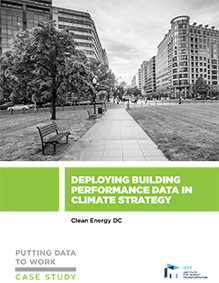Clean Energy DC
Cities are on the front lines of climate change, acutely feeling its impacts while actively working to mitigate its causes. In many cities, buildings are not just the main places citizens spend their time, but they also remain one of the largest contributors to greenhouse gas emissions. As such, addressing their performance plays a critical role in preparing for, rebounding from, and mitigating climate change at the local level.
This case study, part of IMT’s Putting Data to Work toolkit, examines how the District of Columbia used building performance benchmarking data to inform its Clean Energy DC plan. City government sustainability leaders will find this case study a useful model for stakeholder engagement and active use of benchmarking data in climate planning.
A comprehensive toolkit, Putting Data to Work is the result of a three-year pilot project that aimed to use building performance data and asset information to help city government sustainability leaders, utilities, and efficiency program administrators and implementers make more informed business decisions and increase building efficiency. The project examined energy efficiency program design and delivery in the District of Columbia and New York City to produce a toolkit of best practices, actionable tools, and case studies to enable other local governments, utilities, and efficiency program implementers to replicate successes. The full toolkit, as well as details on upcoming blogs and webinars associate with the project, is available at imt.org/PuttingDatatoWork.
